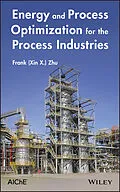Exploring methods and techniques to optimize processing energy efficiency in process plants, Energy and Process Optimization for the Process Industries provides a holistic approach that considers optimizing process conditions, changing process flowschemes, modifying equipment internals, and upgrading process technology that has already been used in a process plant with success. Field tested by numerous operating plants, the book describes technical solutions to reduce energy consumption leading to significant returns on capital and includes an 8-point Guidelines for Success. The book provides managers, chemical and mechanical engineers, and plant operators with methods and tools for continuous energy and process improvements.
Autorentext
FRANK (Xin X.) ZHU is a Senior Fellow at UOP LLC, where he has led innovation efforts to optimize industrial process design and operation to achieve higher energy efficiency and lower capital cost. Before joining UOP, Dr. Zhu served as a research professor at the Centre for Process Integration at the University of Manchester in the UK. He is also a former editor-in-chief of CACS Communications, the magazine of the Chinese-American Chemical Society.
He is the recipient of the 2014 AIChE Energy and Sustainability Award.
Inhalt
PREFACE xv
PART 1 BASIC CONCEPTS AND THEORY 1
1 Overview of this Book 3
1.1 Introduction, 3
1.2 Who is this Book Written for?, 4
1.3 Five Ways to Improve Energy Efficiency, 5
1.4 Four Key Elements for Continuous Improvement, 7
1.5 Promoting Improvement Ideas in the Organization, 8
2 Theory of Energy Intensity 9
2.1 Introduction, 9
2.2 Definition of Process Energy Intensity, 10
2.3 The Concept of Fuel Equivalent (FE), 11
2.4 Energy Intensity for a Total Site, 13
2.5 Concluding Remarks, 15
3 Benchmarking Energy Intensity 16
3.1 Introduction, 16
3.2 Data Extraction from Historian, 17
3.3 Convert All Energy Usage to Fuel Equivalent, 17
3.4 Energy Balance, 21
3.5 Fuel Equivalent for Steam and Power, 23
3.6 Energy Performance Index (EPI) Method, 29
3.7 Concluding Remarks, 32
4 Key Indicators and Targets 35
4.1 Introduction, 35
4.2 Key Indicators Represent Operation Opportunities, 36
4.3 Define Key Indicators, 39
4.4 Set up Targets for Key Indicators, 45
4.5 Economic Evaluation for Key Indicators, 49
4.6 Application 1: Implementing Key Indicators into an "Energy Dashboard," 53
4.7 Application 2: Implementing Key Indicators to Controllers, 56
4.8 It is Worth the Effort, 57
PART 2 ENERGY SYSTEM ASSESSMENT METHODS 59
5 Fired Heater Assessment 61
5.1 Introduction, 61
5.2 Fired Heater Design for High Reliability, 62
5.3 Fired Heater Operation for High Reliability, 68
5.4 Efficient Fired Heater Operation, 73
5.5 Fired Heater Revamp, 80
6 Heat Exchanger Performance Assessment 82
6.1 Introduction, 82
6.2 Basic Concepts and Calculations, 83
6.3 Understand Performance CriterionU Values, 89
6.4 Understanding Pressure Drop, 94
6.5 Heat Exchanger Rating Assessment, 96
6.6 Improving Heat Exchanger Performance, 106
7 Heat Exchanger Fouling Assessment 112
7.1 Introduction, 112
7.2 Fouling Mechanisms, 113
7.3 Fouling Mitigation, 114
7.4 Fouling Mitigation for Crude Preheat Train, 117
7.5 Fouling Resistance Calculations, 119
7.6 A Cost-Based Model for Clean Cycle Optimization, 121
7.7 Revised Model for Clean Cycle Optimization, 125
7.8 A Practical Method for Clean Cycle Optimization, 128
7.9 Putting All TogetherA Practical Example of Fouling Mitigation, 130
8 Energy Loss Assessment 138
8.1 Introduction, 138
8.2 Energy Loss Audit, 139
8.3 Energy Loss Audit Results, 147
8.4 Energy Loss Evaluation, 149
8.5 Brainstorming, 150
8.6 Energy Audit Report, 152
9 Process Heat Recovery Targeting Assessment 154
9.1 Introduction, 154
9.2 Data Extraction, 155
9.3 Composite Curves, 156
9.4 Basic Concepts, 159
9.5 Energy Targeting, 160
9.6 Pinch Golden Rules, 160
9.7 Cost Targeting: Determine Optimal DTmin, 162
9.8 Case Study, 165
9.9 Avoid Suboptimal Solutions, 169
9.10 Integrated Cost Targeting and Process Design, 171
9.11 Challenges for Applying the Systematic Design Approach, 172
10 Process Heat Recovery Modification Assessment 175
10.1 Introduction, 175
10.2 Network PinchThe Bottleneck of Existing Heat Recovery System, 176
10.3 Identification of Modifications, 179
10.4 Automated Network Pinch Retrofit Approach, 181
10.5 Case Studies for Applying the Network Pinch Retrofit Approach, 183
11 Process Integration Opportunity Assessment 195
11.1 Introduction, 195
1...
